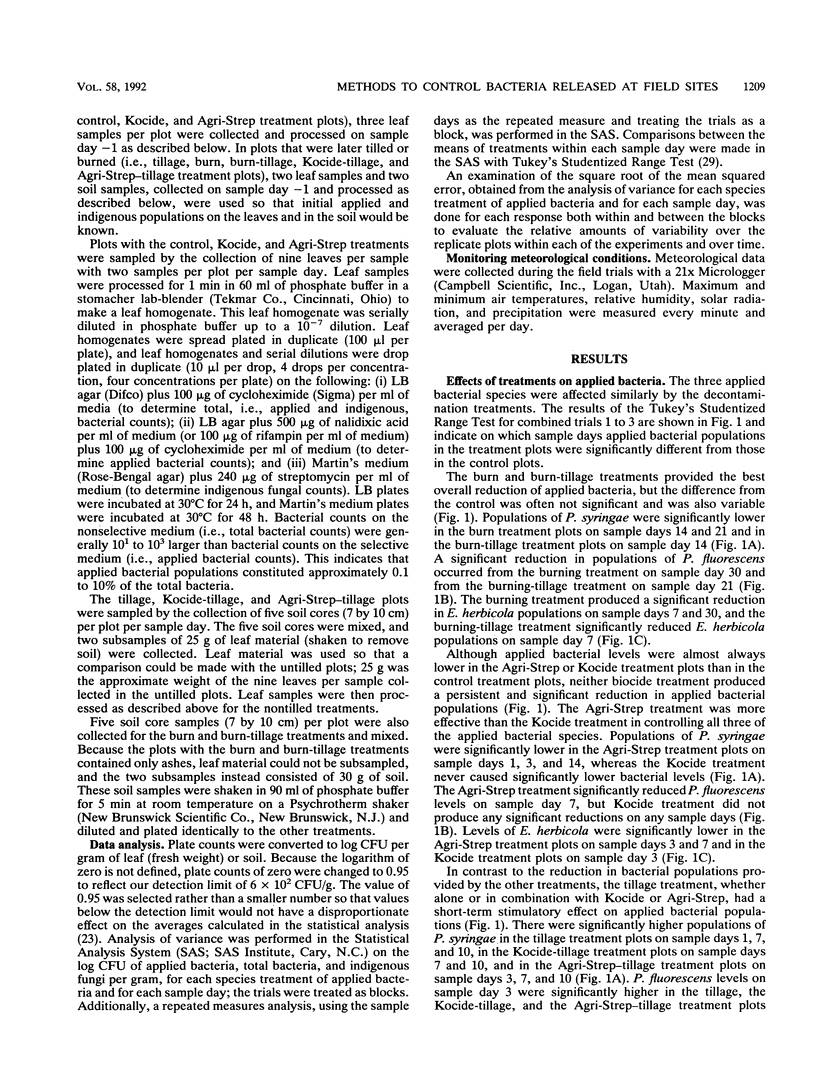Abstract
Decontamination treatments of burning and biocide application, alone and in combination with tillage, were evaluated for their ability to reduce populations of bacteria applied to the leaves of plants in field plots. In addition, the effects of these control methods on indigenous leaf and soil bacteria and fungi were assessed. Field plots of bush beans (Phaseolus vulgaris), sprayed with the bacterium Pseudomonas syringae, Pseudomonas fluorescens, or Erwinia herbicola, received the following treatments: (i) control, (ii) tillage, (iii) burning, (iv) burning plus tillage (burn-tillage), (v) Kocide (cupric hydroxide), (vi) Kocide plus tillage, (vii) Agri-Strep (streptomycin sulfate), and (viii) Agri-Strep plus tillage. Leaves and soil from the plots were sampled at 1 day before and at 1, 3, 7, 10, 14, 21, and 30 days after application of the decontamination treatments. The burn and burn-tillage treatments produced the most significant reductions in bacterial populations. The Agri-Strep treatment was more effective than the Kocide treatment in eliminating applied bacteria, but neither biocide produced consistent or persistent control. In contrast, the tillage treatment, alone or in combination with the Agri-Strep or Kocide treatments, had a short-term stimulatory effect and increased populations of applied bacteria and also levels of indigenous fungi and bacteria. Agri-Strep and Kocide treatments caused significant reductions in indigenous bacterial populations up to 14 days after application and in indigenous fungal populations on day 7 after application. Our results suggest that conventional plant disease control methods may not provide satisfactory control of genetically engineered microorganisms and indicate a need for further development of effective and selective methods to control release microorganisms at field sites.
Full text
PDF







Selected References
These references are in PubMed. This may not be the complete list of references from this article.
- Buttner M. P., Amy P. S. Survival of Ice Nucleation-Active and Genetically Engineered Non-Ice-Nucleating Pseudomonas syringae Strains after Freezing. Appl Environ Microbiol. 1989 Jul;55(7):1690–1694. doi: 10.1128/aem.55.7.1690-1694.1989. [DOI] [PMC free article] [PubMed] [Google Scholar]
- Donegan K., Matyac C., Seidler R., Porteous A. Evaluation of methods for sampling, recovery, and enumeration of bacteria applied to the phylloplane. Appl Environ Microbiol. 1991 Jan;57(1):51–56. doi: 10.1128/aem.57.1.51-56.1991. [DOI] [PMC free article] [PubMed] [Google Scholar]
- Donegan K., Seidler R., Matyac C. Physical and chemical control of released microorganisms at field sites. Can J Microbiol. 1991 Sep;37(9):708–712. doi: 10.1139/m91-120. [DOI] [PubMed] [Google Scholar]
- Lindemann J., Constantinidou H. A., Barchet W. R., Upper C. D. Plants as sources of airborne bacteria, including ice nucleation-active bacteria. Appl Environ Microbiol. 1982 Nov;44(5):1059–1063. doi: 10.1128/aem.44.5.1059-1063.1982. [DOI] [PMC free article] [PubMed] [Google Scholar]
- Oxborrow G. S., Placencia A. M., Danielson J. W. Effects of temperature and relative humidity on biological indicators used for ethylene oxide sterilization. Appl Environ Microbiol. 1983 Feb;45(2):546–549. doi: 10.1128/aem.45.2.546-549.1983. [DOI] [PMC free article] [PubMed] [Google Scholar]
- Rutala W. A., Stiegel M. M., Sarubbi F. A., Jr Decontamination of laboratory microbiological waste by steam sterilization. Appl Environ Microbiol. 1982 Jun;43(6):1311–1316. doi: 10.1128/aem.43.6.1311-1316.1982. [DOI] [PMC free article] [PubMed] [Google Scholar]


